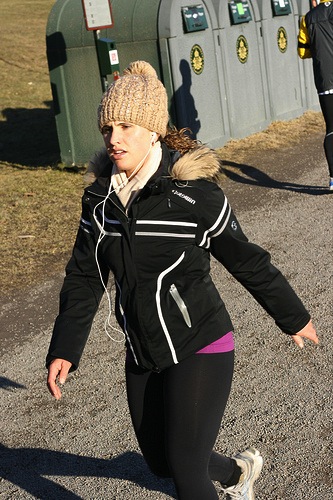It shouldn’t surprise me that the beginning of my 28-day commitment to #VionicWalkabout Quest for Good Health would begin in the midst of some of our coldest days of winter. This is New England after all.
I figure there are four options to start on the right foot with my new Zen walking shoes:
1. Hit the gym (or my parents’ house) – Claim a treadmill and walk nowhere for a half-hour. As long as you’re moving consistently with your heart rate up, I say using the stair-master, elliptical machines, riding a bike or a combination of these works just as well for the challenge. I love listening to energizing music with a driving beat to help me stay on pace and make the time go by faster.
With so much fitness equipment at my disposal for free, it’s not likely I will be using a gym anytime soon. However, I may make an exception later in the month as a gym in a neighboring town is hosting a Free Fitness Open House Week toward the end of march. If temperatures don’t heat up by then, it will be the perfect time to try out one of their treadmills with a personal viewing screen. Turning the channel to something with a scenic view, I can imagine I am viewing the sights and breathing in the fresh air of the outdoors. Perhaps I may also take a dip in their swimming pool to further remind me warmer weather is ahead.
2. Walk the mall – When temperatures drop, and I still want to get in a walk, a mall is definitely my top choice. There’s no need to power walk like walking groups, but you certainly want to keep a fairly brisk pace to keep your heart rate up. Turn navigating between pokey shoppers into a game—scan ahead and plot out the maze that will lead you into open walking space again.
What are the perks of walking in the mall?
• People watching – If you can’t have a view of outdoor nature, there is an amazing opportunity to see human nature at its most diverse in the mall. You observe the interactions between parents and kids, between romantic partners, between customers and sales clerks and even people strolling the mall alone.
• Window-shopping – You may not have time to linger for long, but some stores are getting more creative with their window displays. Grab inspiration, add things to your dream list or find items you want to check out in detail when you next return to the mall—or after your walk.
3. Climb stairs – Done properly, climbing actual stairs can be great aerobic exercise, working the heart and lungs. It builds and shapes muscle. Stair climbing works your quads, hamstrings and calf muscles, as well as your glutes, aka your butt. It also can help with weight loss.
Cedric Bryant, chief science officer for the American Council on Exercise told the New York Times that the challenging vertical climb of stairs allows you to burn more calories than jogging or cycling at a moderate pace. Meanwhile the impact on knees and feet is less than running—at least uphill. One should descend stairs with caution, as the pressure equals six to seven times one’s body weight, Dr. Bryant said.
Walking up stairs at a moderate pace could burn 5 calories per minute in a 120-pound person and 9 for a 180-pound person, according to Bryant. For those not in the best condition, climbing stairs instead of taking elevators can be a great place to start adding more activity to their life.
As you grown more comfortable, try taking two steps at once or hold a kettlebell or other type of weight in each hand. You can take it to the next level by running up the stairs. According to Bryant, the heart benefits and caloric burn are multiplied if you run them. Alternate between running up the stairs and walking down them.
4. Braving the great outdoors -While I personally choose to stay inside when the weather is particularly cold, some dedicated walkers are determined to walk outdoors in any weather. The key to walking in cold weather is to wrap up in layers, as your body temperature’s rise with exercise will outpace the elements. Of course, you’ll also want to wear a hat and gloves.
You should have a base layer, an insulating layer and water-resistant outer layer. The base layer, consisting of your undershirt and running pants, should be made of a wicking fabric to absorb moisture and keep your skin dry. Wearing wicking undergarments can also prevent clinging sweat. Go with synthetics instead of cotton. An insulating layer, like fleece, can be removed if you start to overheat. Your jacket should have a hood and be water-resistant and wind-resistant to help ward off any precipitation or the punishing lash of wind. Wear wicking liner socks under wool socks or look for a combo of the two.
Keep your ears and face covered as much as possible. Consider a scarf or a balaclava that covers your head and neck. And even if it’s not particularly sunny out, protect your eyes and skin—even light reflection off a blanket white snow can be blinding. To prevent chapped lips, apply lip balm with sun protection. Also make sure your walking shoes have good traction. Make sure you’re wearing bright enough colors that drivers can see you. High snow piles can decrease visibility for vehicles, so always be on alert.
Finally, please wait for warmer weather to go outside if it is icy or temperatures—including any wind chill—drop to -20 degrees or below.
SO DEAR READERS: Which path would YOU should choose?

Leave a Reply